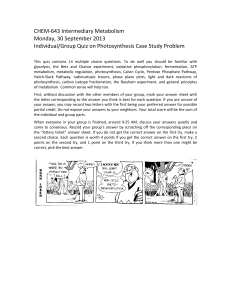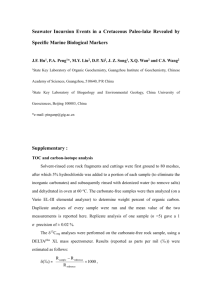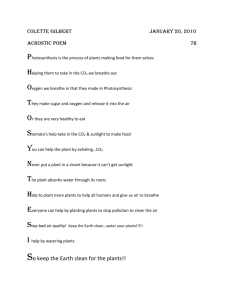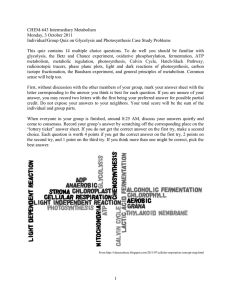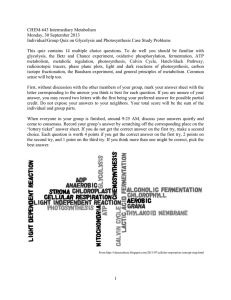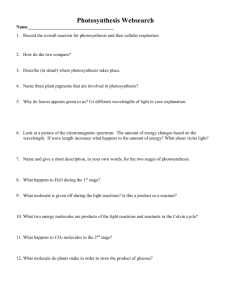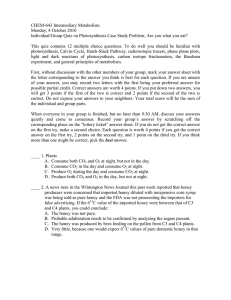CHEM-643 Intermediary Metabolism Name ________________________ Monday, 1 October 2007
advertisement
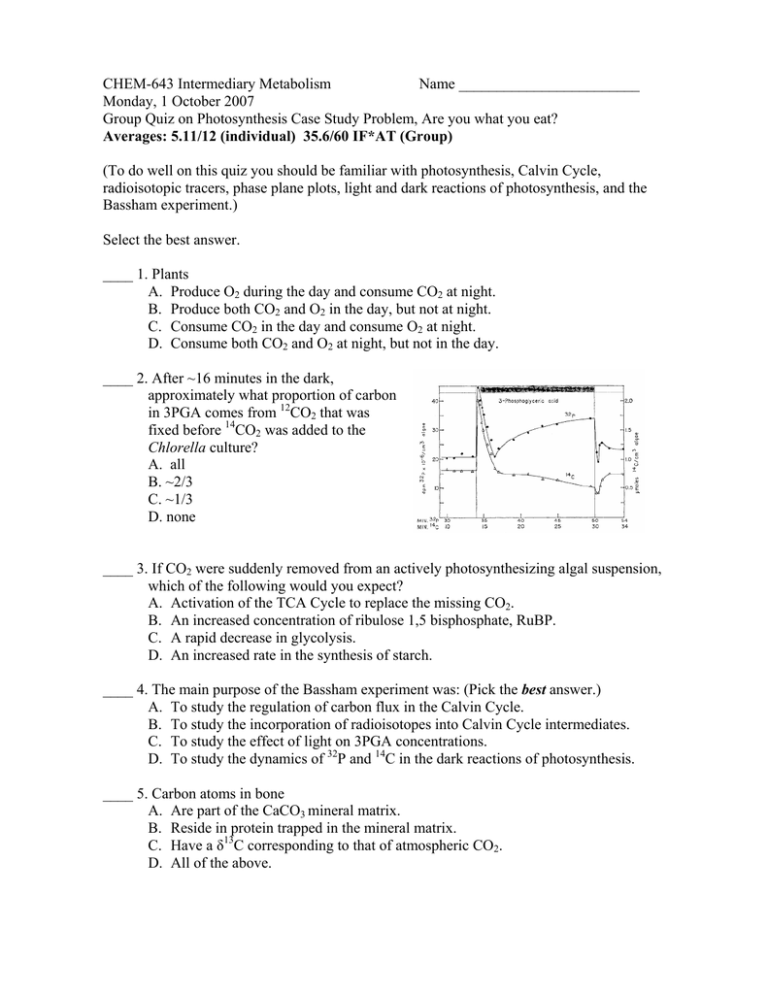
CHEM-643 Intermediary Metabolism Name ________________________ Monday, 1 October 2007 Group Quiz on Photosynthesis Case Study Problem, Are you what you eat? Averages: 5.11/12 (individual) 35.6/60 IF*AT (Group) (To do well on this quiz you should be familiar with photosynthesis, Calvin Cycle, radioisotopic tracers, phase plane plots, light and dark reactions of photosynthesis, and the Bassham experiment.) Select the best answer. ____ 1. Plants A. Produce O2 during the day and consume CO2 at night. B. Produce both CO2 and O2 in the day, but not at night. C. Consume CO2 in the day and consume O2 at night. D. Consume both CO2 and O2 at night, but not in the day. ____ 2. After ~16 minutes in the dark, approximately what proportion of carbon in 3PGA comes from 12CO2 that was fixed before 14CO2 was added to the Chlorella culture? A. all B. ~2/3 C. ~1/3 D. none ____ 3. If CO2 were suddenly removed from an actively photosynthesizing algal suspension, which of the following would you expect? A. Activation of the TCA Cycle to replace the missing CO2. B. An increased concentration of ribulose 1,5 bisphosphate, RuBP. C. A rapid decrease in glycolysis. D. An increased rate in the synthesis of starch. ____ 4. The main purpose of the Bassham experiment was: (Pick the best answer.) A. To study the regulation of carbon flux in the Calvin Cycle. B. To study the incorporation of radioisotopes into Calvin Cycle intermediates. C. To study the effect of light on 3PGA concentrations. D. To study the dynamics of 32P and 14C in the dark reactions of photosynthesis. ____ 5. Carbon atoms in bone A. Are part of the CaCO3 mineral matrix. B. Reside in protein trapped in the mineral matrix. C. Have a δ13C corresponding to that of atmospheric CO2. D. All of the above. CHEM-643 Photosynthesis Quiz Monday, 1 October 2007 Page 2 ____ 6. Ribulose 1,5 bisphosphate carboxylase A. Functions primarily in the light B. Is one of the “dark reactions” of photosynthesis C. Discriminates against 13CO2 more than does PEP carboxylyase. D. All of the above. ____ 7. The half-life of 14C is about 5700 years. What percent of the 14C originally present in a 57,000 year old fossil would remain today? A. ~10% B. ~1% C. ~0.1% D. ~0.01% ____ 8. The carbon atoms in nylon A. Would have a significantly different δ13C than gasoline. B. Include essentially no 14C. C. Are derived directly by chemical synthesis from atmospheric CO2. D. Are derived from corn starch and cellulose. ____ 9. The belemnite used as a δ13C reference standard and also the state fossil of Delaware A. Is an extinct type of mollusk related to squid and cuttlefish. B. Has a lower 13C/12C ratio than the carbon in either C3 or C4 plants. C. Is composed of hydroxyapatite, Ca5(PO4)3OH. D. Has a 14C/12C ratio similar to that in atmospheric CO2. ____ 10. Ignoring photorespiration, the ratio of ATP:NADPH consumed per each CO2 fixed by the Calvin Cycle is __ in C3 plants: A. 1:1 B. 2:1 C. 3:2 D. 1:2 0 ____ 12. The point on the graph to the right represents the concentrations of 3PGA and RuBP at the moment the lights were turned off in Bassham’s experiment. Plot the point corresponding to their concentrations about 30 sec later when [3PGA] peaks. What would be the expected slope (m = Δ[3PGA]/Δ[RuDP]) of the line connecting ● and the point you plotted? A. m ≥1 B. 0 < m < 1 C. -1 < m < 0 D. m ≤ -1 [3PGA] ____ 11. Consider two identical photosynthesizing leaves placed in separate vessels containing atmospheric carbon dioxide. Vessel 1 is sealed so new air cannot come in, while the Vessel 2 remains open to the air. Photosynthesis is allowed to continue until the CO2 in Vessel 1 is used up. What can you predict about the δ13C values for newly fixed carbon? A. δ13C Vessel 1 > δ13C Vessel 2 B. δ13C Vessel 1 < δ13C Vessel 2 C. δ13C Vessel 1 = δ13C Vessel 2 D. δ13C Vessel 2 = δ13C atmospheric CO2. ● 0 [RuBP]

